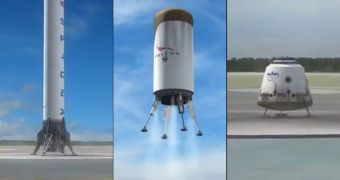Officials at the Space Exploration Technologies Corporation (SpaceX) announce plans to augment their rocket and space capsule ranges with the world's first fully-reusable delivery system. The rocket would be able to deliver its cargo, and then return to land vertically near its launch pad.
In addition to the rocket itself, the capsule atop the delivery system will also be reusable, capable of reentering Earth's atmosphere and carrying out a powered landing. This means that it will not splash in the ocean or parachute to the ground, like Soyuz and Apollo capsules.
This method of space exploration, representatives from the Hawthorne, California-based company explain, will allow humans to travel to Mars and the Moon, seeing how both the rocket and its manned capsule can land on any straight surface in the solar system.
The announcement was made on Thursday, September 29, by SpaceX founder and CEO, and PayPal co-founder, Elon Musk. He detailed his company's plans during a speech he made at the National Press Club (NPC) in Washington, DC, Space reports.
However, Musk admitted that the task the company has taken on is extremely complex, requiring a tremendous level of innovation and a lot of money to complete. At this point, SpaceX is not yet sure about when it is able to put this reusable system into active duty.
“We will see if this works. And if it does work, it'll be pretty huge,” Musk told attendants. Still, he added, one of the main reasons SpaceX was founded in the first place was to develop a way of ensuring that humankind will establish a continuous presence in low-Earth orbit and beyond.
Within 10 to 20 years, the company hopes to be able to develop a reusable system – and associated technologies – efficient enough to go to Mars. Such a mission holds massive technological and engineering challenges, but it is not impossible.
NASA itself is eying a Martian expedition by 2035, using the newly-announced Space Launch System (SLS) and the Orion Multi-Purpose Crew Vehicle (MPCV). The two are scheduled to fly together for the first time in 2017m when the first SLS prototype will launch.
“We have a design that on paper – doing the calculations, doing the simulations – it does work. Now we need to make sure those simulations and reality agree because generally, when they don't, reality wins,” Musk said of the newly-proposed system.

 14 DAY TRIAL //
14 DAY TRIAL //